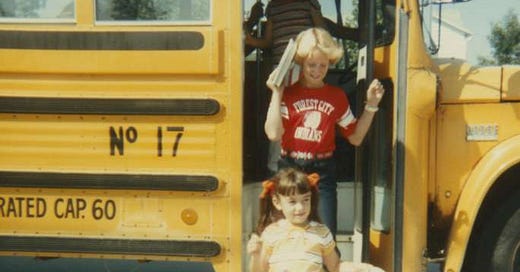May is national Mental Health Awareness Month, did you know that? And May 5-7 is Children’s Mental Health Awareness week, something I didn’t know until recently.
I was all set to write about mental health statistics and legislation and resources—something I do regularly in this column—but instead found myself thinking about the school bus I rode as a child. Weird, right? What does a yellow bus back in the 1980s have to do with mental health?
Allow me to explain.
When I was a kid, my school bus became ground zero for my first bout with serious anxiety and depression. Around fourth grade I inexplicably developed two very specific and crippling fears: motor vehicle accidents and vomit. And both fears manifested every single day, twice a day, during my long, rural school bus route. I lived on a farm in southern Iowa, on the far west side of the county, so it wasn’t uncommon to ride the bus for an over an hour each way, mostly on narrow, curvy, gravel roads.
School buses in the 80s weren’t like school buses today. The vehicles themselves were old and rode like a rough wagon across boulders, with windows that rattled and slipped down (rain or shine), and the thin stuffing pouring out of the cracked vinyl seats. Our drivers were sometimes rough, too. Discipline was different back then and it wasn’t unusual for a driver to slam on the brakes and scream at us to shut up or knock it off. One driver kept a wooden paddle tucked behind the front mirror. Another tied a misbehaving kid’s hands to the front post.
I also had one particular driver with a “lead foot,” as they say, who took corners so fast it felt like we tipped on two wheels, and repeatedly hit a washed out country bridge at the bottom of a hill so hard kids screamed in pain from compressed spines.
Every day I was terrified of smashing my nose on the seat in front of me with an abrupt stop, of my back snapping in half, or the bus finally tipping over into the ditch and killing us all.
You see where I’m going with this. Triggering source of anxiety number one.
Before the era of modern security cameras today, kids did all kinds of terrible shit on school buses and got away with it. Stabbed each other with sharpened pencils, stole lunches and snacks, dared each other to do and eat disgusting things. I once saw a boy glue the tip of his penis shut on a dare with Elmer’s glue, and another kid eat a moth larvae, which of course made him violently vomit all over the bus floor. My lifelong best friend also rode a long rural bus route and experienced similar incidents. A kid spitting phlegm in her hair, another eating a series of flies, and again, violently throwing up.
Triggering source of anxiety number two.
Over time, the two phobias grew so pervasive that boarding the bus each day nearly made me hyperventilate and feel faint. Some mornings I cried and made up fake illnesses so I could stay home, to no avail. Not only did the phobias and anxiety persist, but they worsened to the point I developed what would now be considered adolescent depression. I felt so weird and alone.
I didn’t know what anxiety, phobias, or depression was or how to explain what was I feeling, and I know my parents were at a loss as to what the hell was wrong with me. I remember my mother growing so concerned that she took me to our family doctor, who said nothing was wrong with me and I should just stop eating sugar and everything would fine.
By sixth grade, I was so overwhelmed with anxiety and depression I thought about swallowing an entire bottle of Tylenol. I was eleven.
Life chugged along this way for several more years until I entered puberty, when for some unknown reason, my extreme phobias, anxiety, and depression gradually improved on their own. I just put it behind me and moved on with life. Such is the attitude of most Gen X kids. So many of us had practically feral childhoods and were lucky to survive. It wasn’t our parents’ faults. It was just a wild era.
By the time I became a mother myself, parenting and discussions around mental health had changed. It was finally understood that children as well as adults can suffer from mental health issues, and we now have terminology to talk openly about it, and strategies to help deal with it.
I’ve had a few episodes of anxiety and minor depression as an adult, but learned when to recognize the early signs, and developed tools to help manage them.
I still sometimes think about that little eleven-year-old version of myself when I see a school bus. My best friend and I, some forty years later, can even now laugh about the funnier stories of our shared school bus traumas. And more and more I meet adults who talk about similar childhood anxieties, phobias, and bouts with mental health struggles. They’re more common in kids than we think.
But more than anything, I’m so grateful that today we have a month devoted to mental health awareness, and even a special week to acknowledge it in children.
That we have terminology for what a child might be going through, and that we can tell them they’re not weird or alone.






A vivid, powerful essay that put me inside the school bus. Just OMG. 😳 Well done.
Excellent piece! I love hearing points of view of others who have experienced mental health issues. Makes me feel less alone in my own journey.